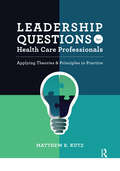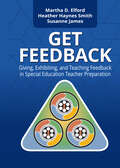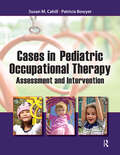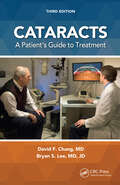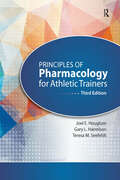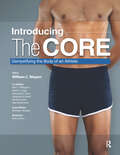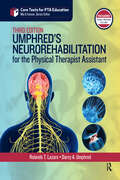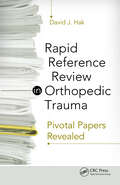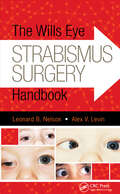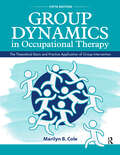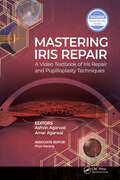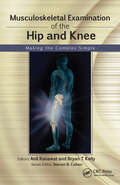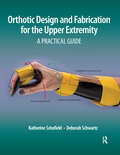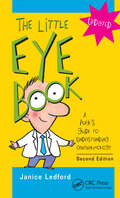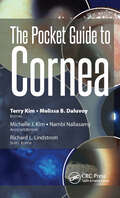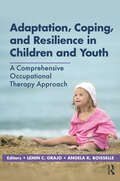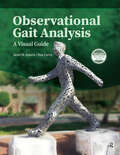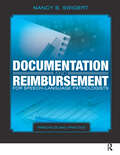- Table View
- List View
Leadership Questions for Health Care Professionals: Applying Theories and Principles to Practice
by Matthew KutzLeadership Questions for Health Care Professionals: Applying Theories and Principles to Practice by Dr. Matthew R. Kutz presents some of the most common leadership questions with the intent to facilitate intrigue and dialogue about the general concept of leadership and an awareness of potential leadership issues facing health care professionals.Leadership Questions for Health Care Professionals presents responses that will initiate discussion, as well as offer solutions based on the best available evidence across a wide spectrum of relevant research. Discussion questions at the end of each response will allow the reader to engage in critical thinking and re-evaluate their experiences and offer new insights into their leadership journey.Sections include questions on key issues for health care professionals: The essence of leadership Leadership development Teamwork and communication Change Organizational culture and complexity Leadership ethics and power Diversity and multicultural leadership Leadership Questions for Health Care Professionals takes an interprofessional and interdisciplinary approach and is relevant for athletic trainers, physical therapists, occupational therapists, speech-language pathologists, nurses, physicians, and more.Leadership Questions for Health Care Professionals: Applying Theories and Principles to Practice offers students a broader conceptual understanding of leadership, as well as the depth required by seasoned health care clinicians, managers, and executives who are looking for practical and evidence-based insights to their toughest leadership issues.
Evaluation and Management of Common Upper Extremity Disorders: A Practical Handbook
by Peter Millett Rachel RohdeEvaluation and Management of Common Upper Extremity Disorders: A Practical Handbook answers the need for a comprehensive, yet concise reference that addresses practical solutions to everyday conditions that general orthopedic surgeons, and specialists alike, as well those involved with general musculoskeletal surgical and nonsurgical care, may encounter.User friendly and pocket size, Evaluation and Management of Common Upper Extremity Disorders by Drs. Rachel S. Rohde and Peter J. Millett provides information on how to diagnose, treat, and manage the most commonly encountered conditions of the upper extremity.Each condition addresses:• Mechanism of injury• Key examination points• Additional testing or imaging• Treatment options (operative and nonoperative)• Surgical anatomy• Surgical procedures• Rehabilitation• Expected outcomes• Potential complicationsJust a few of the conditions covered inside:• Trigger finger and de Quervain’s tenosynovitis• Distal radius fractures• Cubital tunnel syndrome• Distal biceps tendon rupture• Rotator cuff tears• Shoulder instabilityWritten in a bullet format, and including photos for quick, easy reference, Evaluation and Management of Common Upper Extremity Disorders: A Practical Handbook contains valuable information for all levels of training and experience. General orthopedic surgeons, orthopedic surgery residents and fellows, orthopedic surgery physician assistants, nurse practitioners, and nonoperative sports medicine specialists will welcome this thorough evaluation of common upper extremity disorders.
The Occupational Therapist’s Workbook for Ensuring Clinical Competence
by Marie Morreale Debbie AminiThe Occupational Therapist’s Workbook for Ensuring Clinical Competence is designed to help occupational therapy students and new practitioners demonstrate the practical problem-solving and real-life clinical reasoning skills essential for fieldwork and clinical practice. This user-friendly resource helps the reader apply occupational therapy concepts, improve narrative and pragmatic reasoning skills, and measure attainment of knowledge and skills needed for successful transition to fieldwork and entry-level practice.Inside The Occupational Therapist’s Workbook for Ensuring Clinical Competence, a wide variety of client conditions, situations, and intervention options are presented for different practice areas. Knowledge and skills are assessed for fundamental aspects of occupational therapy such as: professionalism, ethical decision-making, evidence-based practice, evaluation and intervention planning, occupation-based interventions, effective communication, supervision, role delineation, activity analysis, cultural competence, interprofessional collaboration, group process, emerging practice areas, department management, safety, documentation, billing and reimbursement, and more.Marie Morreale and Debbie Amini have incorporated numerous worksheets, learning activities, and worksheet answers in an easy-to-read format. The variety of assessment methods and learning activities used throughout the text stem from the authors' combined decades of teaching experience and include: case studies; vignettes; multiple choice, matching and true/false questions; fill in the blanks; experiential activities and more. Topics are broken down into smaller units and explained step-by-step to allow for easy independent study.Thoroughly explained answers are provided so that readers can check their responses with suggested best practice.These worksheets and learning activities are also useful as role-playing exercises, studying in small groups, and can aid in preparing for fieldwork or the national certification exam.Included with the text are online supplemental materials for faculty use in the classroom.The Occupational Therapist’s Workbook for Ensuring Clinical Competence is the go-to text for occupational therapy students and faculty, as well as new occupational therapy practitioners who require the practical problem-solving skills and the clinical decision-making skills essential for fieldwork and clinical practice.
GET Feedback: Giving, Exhibiting, and Teaching Feedback in Special Education Teacher Preparation
by Susanne James Heather Smith Martha Elford“A powerful and rich resource of great ideas that will move the debates about feedback into the most worthwhile areas."—John Hattie, PhD, University of Melbourne, Victoria, AustraliaPerfect for special education teacher preparation faculty, coordinators, and administrators, GET Feedbackprovides examples, activities, and support for integrating and aligning feedback instruction, demonstrating the importance of putting the adult learner, as the feedback recipient, at the center of every feedback opportunity. Written in an approachable, easy-to-read format, this text is the first book to specifically examine feedback for adult learners. Drs. Martha D. Elford, Heather Haynes Smith, and Susanne James use the G.E.T. Model (give, exhibit, teach) to provide structure for feedback through four domains: specificity, immediacy, purposefulness, and constructiveness.GET Feedback combines Adult Learning Theory with education research to provide a comprehensive, integrated framework to teach feedback in special education teacher preparation. This text will improve how special education teacher educators “GET” feedback across courses and programs.
Interprofessional Evidence-Based Practice: A Workbook for Health Professionals
by Penelope Moyers Patricia Finch-GuthrieInterprofessional Evidence-Based Practice: A Workbook for Health Professionals promotes active, team learning of interprofessional evidence-based practice (EBP). This book is distinctive in that it departs from the tradition of evidence-based practice occurring from a single disciplinary perspective. Interprofessional evidence-based practice is described in terms of a dynamic team process that blends the patient’s preferences and values, the expertise of practitioners from multiple disciplines, and incorporates multidisciplinary evidence. Teams learn to use the nine phases in the interprofessional process to challenge current disciplinary paradigms and biases to create an integrated approach to patient care, healthcare delivery, or population health.Drs. Penelope Moyers and Patricia Finch Guthrie focus on developing and fostering collaboration between academic institutions and healthcare organizations so that students and faculty participate on interprofessional teams with mentors and staff from a healthcare organization. Interprofessional Evidence-Based Practice: A Workbook for Health Professionals also addresses the communication and cross-organizational factors important for supporting the work of the team. Common team and mentoring issues encountered in EBP are clearly articulated, along with the iterative problem-solving approaches necessary to mitigate temporary “stumbling blocks.”The book provides detail for developing and launching an Interprofessional Evidence-Based Practice program that goes beyond the evidence process to include implementation science to support practice change. Approaches for developing partnerships for supporting this type of program between universities and health care institutions are contained within, including sample partnership agreements and resource-sharing strategies.Inside Interprofessional Evidence-Based Practice: A Workbook for Health Professionals, each chapter includes performance objectives, key words, checklists, and materials and resources that an interprofessional team can use. PowerPoint lectures, mentor newsletters, forms, tools, and other resources are included on a companion website to guide team learning about key EBP topics, as well as to support the program coordinators and team mentors in their work with the interprofessional teams.Interprofessional Evidence-Based Practice: A Workbook for Health Professionals is the go-to resource for those who want to engage in interprofessional evidence-based practice, and for leaders who want to develop and implement an interprofessional evidence-based practice program.
Curbside Consultation in Pediatric Ophthalmology: 49 Clinical Questions (Curbside Consultation in Pediatrics)
by Rudolph WagnerAre you looking for concise, practical answers to those questions that are often left unanswered by traditional pediatric ophthalmology references? Are you seeking brief, evidence-based advice for complicated cases or controversial decisions? Curbside Consultation in Pediatric Ophthalmology: 49 Clinical Questions provides quick answers to the tricky questions most commonly posed during a “curbside consultation” between pediatricians. Dr. Rudolph Wagner has designed this unique reference which offers expert advice, preferences, and opinions on tough clinical questions commonly associated with pediatric ophthalmology. The unique Q&A format provides quick access to current information related to pediatric ophthalmology with the simplicity of a conversation between two colleagues. Numerous images, diagrams, and references allow readers to browse large amounts of information in an expedited fashion. Some of the questions that are answered: • How do I make the diagnosis of amblyopia?• How can I differentiate a true strabismus from a pseudo-strabismus? • How do I diagnose and treat corneal abrasions? Does patching remain an important component of therapy?• What is naso-lacrimal duct obstruction? How is it managed? When should I refer these children? • How can I determine if a “red eye” is caused by a bacterial infection, viral infection or an allergic reaction? How are they managed?Curbside Consultation in Pediatric Ophthalmology: 49 Clinical Questions provides information basic enough for residents while also incorporating expert advice that even high-volume pediatricians will appreciate. Pediatricians, nurse practitioners, emergency room physicians, physician assistants and family practitioners will benefit from the user-friendly, casual format and the expert advice contained within.
Cases in Pediatric Occupational Therapy: Assessment and Intervention
by Susan Cahill Patricia BowyerCases in Pediatric Occupational Therapy: Assessment and Intervention is designed to provide a comprehensive collection of case studies that reflects the scope of current pediatric occupational therapy practice.Drs. Susan Cahill and Patricia Bowyer, along with more than 50 contributors, begin each section with an introduction to the practice setting and direct instructors and students to additional resources for more information. The text includes more than 40 cases that include client overviews, relevant history and background information; information regarding the analysis of occupational performance; information about progress in treatment; and questions to promote the development and refinement of clinical reasoning skills.Cases are presented from various practice settings, including: The neonatal intensive care unit Early intervention School systems Outpatient services Hospital-based settings Mental health settings Community settings Each case included in Cases in Pediatric Occupational Therapy is written by professionals with first-hand experience working with pediatric clients from the specific practice setting, and it aligns with the occupational therapy process represented in the AOTA’s Occupational Therapy Practice Framework, Third Edition. In addition, supplemental information, photographs, and video clips help to bring the cases to life. Included with the text are online supplemental materials for faculty use in the classroom.Cases in Pediatric Occupational Therapy will guide occupational therapy students, faculty, and practitioners through effective clinical decision making during the selection of assessment procedures and the development of client-centered and context-specific intervention plans.
Psychopathology and Function
by Bette BonderA comprehensive guide to understanding mental health, Psychopathology and Function, Sixth Edition offers helpful insights and strategies for occupational therapists to understand the approaches of other disciplines, such as medicine, physical therapy, social work, psychology, and nursing, and work effectively in the care team. An essential occupational therapy resource for more than 30 years, Dr. Bette Bonder’s Psychopathology and Function, Sixth Edition clearly describes occupational therapy’s unique perspectives and contributions to improving the lives of those struggling with emotional and psychological challenges. The Sixth Edition offers an overview of important research and discusses current and emerging issues and knowledge of mental health issues. Readers will gain an appreciation of the centrality of occupation and meaning to mental health and quality of life as they understand how occupational therapy can emphasize and assert its value. New updates in the Sixth Edition include: • Increased emphasis on issues of social justice • Incorporation of material about the impact of the COVID-19 pandemic on mental health issues • A new chapter on gender dysphoria • A new chapter on sociocultural factors in mental disorders • A streamlined and updated pharmacology chapter • A discussion about the DSM-5 and the reactions to it 5 years after its release A great resource for occupational therapy students and practitioners, Psychopathology and Function, Sixth Edition recognizes the importance of interventions focused on quality of life. This text offers background knowledge and strategies that can support efforts to address social and situational issues.
Cosmetic and Clinical Applications of Botox and Dermal Fillers
by William J. Lipham Jill MellicherThere has been a recent explosion of public interest in less invasive facial rejuvenation products and treatments. At the forefront of this are the U.S. FDA Approvals of Botox and Xeomin injections.In addition to the broad array of cosmetic applications for botulinum toxin, a new range of functional treatments is similarly beginning to emerge. These treatments include creating a “chemical” tarsorrhaphy to promote corneal healing, reducing thyroid-associated eyelid retraction, and—most compelling—reducing the frequency and severity of muscle tension and migraine headaches. These new applications significantly expand the scope of botulinum toxin treatments for medical disorders that have traditionally included the treatment of strabismus as well as a number of disorders of spasticity.Cosmetic and Clinical Applications of Botox and Dermal Fillers, Third Edition by Dr. William J. Lipham and Dr. Jill S. Melicher continues to evolve and advance along with these applications, addressing important information for anyone interested in expanding his or her clinical practice in this area.This updated and revised Third Edition also describes how to perform a broad range of treatments with a wide variety of dermal filler agents, including the newer hyaluronic acid and poly-l-lactic acid derivatives.Topics inside the Third Edition include: Treatment of blepharospasm, meige syndrome, and hemifacial spasm Botulinum toxin as a treatment for functional disorders Neuro-ophthalmic uses for botulinum toxin Cosmetic applications of botulinum toxin Periorbital rejuvenation using cosmetic filler agents and fat injection Marketing botulinum toxin and dermal filler agents to build your practice Additionally, an accompanying video website with nine supplemental videos is included to demonstrate the techniques discussed.Video topics include: Botulinum toxin for benign essential blepharospasm Botulinum toxin for hemifacial spasm Botulinum toxin for headaches Botulinum toxin chemical brow lift Botulinum toxin for forehead rhytids Botulinum toxin for glabellar rhytids Botulinum toxin for treatment of orbicularis lateral Hyaluronic acid filler for perioral rejuvenation Hyaluronic acid filler for the nasolabial fold Cosmetic and Clinical Applications of Botox and Dermal Fillers, Third Edition is perfect for anyone interested in the use of Botox and dermal filler agents for a wide variety of functional and minimally invasive facial rejuvenation procedures. General ophthalmologists, anterior segment surgeons, dermatologists, facial plastic surgeons, residents, and fellows alike will benefit from adding this valuable book and video website to their collection.
Cataracts: A Patient’s Guide to Treatment
by David F. Chang Bryan LeeIf you have been diagnosed with cataracts or are concerned you may have them, get detailed and understandable answers to your questions with Cataracts: A Patient’s Guide to Treatment, Third Edition, newly updated to include the latest information on rapidly-evolving cataract surgical and lens implant technologies. Even though cataract surgery is performed several million times a year, it is common for patients to have questions, concerns, and misconceptions when it comes to the surgery. This useful resource covers the most commonly asked questions with clear, understandable explanations. Two of the country’s foremost cataract experts, Dr. David F. Chang and Dr. Bryan S. Lee, walk readers through the procedure and explain why cataracts form, how they are diagnosed, how they are treated, and what other eye conditions may affect cataract surgery, all in a way that is easily understandable for patients and their families.Cataracts: A Patient’s Guide to Treatment, Third Edition is easy-to-read and brief in length. It nonetheless provides comprehensive information on patient-specific issues that affect cataract surgery success and outcomes. It serves as an excellent supplement to information and advice obtained from the patient’s own eye doctor.A few of the questions answered inside Cataracts: A Patient’s Guide, Third Edition: How are cataracts diagnosed? How do I know if I should have cataract surgery? What kind of anesthesia is used during surgery? Which of the intraocular lens implant options should I consider? What is the role of lasers in cataract surgery? What is the recovery like after surgery? Will I still need glasses or contacts after surgery? Can I have surgery if I have glaucoma or other eye conditions? After reading Cataracts: A Patient’s Guide, Third Edition, you will be able to make a well-informed decision about cataract surgery and will understand much more about the range of artificial lens implant options that can get you seeing clearly again.
Principles of Pharmacology for Athletic Trainers
by Joel Houglum Gary Harrelson Teresa SeefeldtPrinciples of Pharmacology for Athletic Trainers, Third Edition continues the tradition of past editions to provide applications of pharmacological principles specifically aimed at the athletic trainer. The drug categories that are included are primarily those that may be pertinent to the treatment of athletic injuries or that may affect athletic performance.Drs. Joel Houglum, Gary Harrelson, and Teresa Seefeldt have taken a unique aspect to the organization and design of the Third Edition to be instructional discussions regarding the use and effects of drugs and of the disease states treated by these drug categories. Additionally, there is a specific discussion of the role of the athletic trainer regarding the therapeutic use and effects of these drugs.Features of the Third Edition: Satisfies all of the CAATE Educational Competencies on pharmacology Advanced organizers and specific learning objectives at the beginning of each chapter Summaries after each major topic within the chapter Case studies and clinical applications Discussion on popular fitness supplements Key words are in italics and defined in the glossary Concept maps present important, yet complex, processes in a concise, graphical way Shaded textboxes throughout include additional information and are beneficial for the reader to recall a key concept addressed in an earlier chapter New ancillary materials specifically for faculty that include PowerPoint slides and test bank questions for each chapter Included with the text are online supplemental materials for faculty use in the classroom.Principles of Pharmacology for Athletic Trainers, Third Edition will continue to be the go-to resource to determine the best pharmacological treatment strategy and management by athletic trainers.
Introducing the Core: Demystifying the Body of an Athlete
by Michael J. Bradley Rob Gordon Marc J. Philippon Adam C. Zoga Alexander E. Poor Johannes B. Roedl Jim McCrossin Alex McKechnieThere is no more important area of the body for an athlete than the core, the region of our body from our chest to our knees. The core is our engine, our hub of activity. Strength there makes life easier for shoulders and knees. It produces speed and explosiveness. Endurance and grit.The core is so important. So why has it remained such a medical mystery?This book will explain that.Introducing the Core: Demystifying the Body of an Athlete traces the arc of the journey from injury to restoration of power to the return to normal life.Dr. William Meyers is the nation’s foremost authority on core health. Along with over 40 world-renowned expert contributors, Dr. Meyers explains how the core functions through stories from his work in locker rooms, the operating room, and the playing fields of elite athletes, giving readers a thorough understanding of the core’s widespread influence on athleticism and the human anatomy.The book: Dissects the events that led Dr. Meyers and his team of experts to their new appreciation of this anatomy Brings multiple world-renowned arthroscopists into the overall core picture, providing their perspectives on how the core works, with the pubic bone as “the sun” of the body’s universe Offers insight into the many causes of pelvic pain, demonstrating why the term “sports hernia,” should be banished forever Emphasizes the fact that a wide spectrum of professionals treat the core -- from traditional surgeons to alternative therapists Brings it all together and proposes a new future, and perhaps a new medical specialty, that is the core “Strength, power, and endurance all flow from the core. This book, and the work Bill Meyers has done in the field, will bring good core health to the forefront and help everyone—elite athletes and others.”—Michael William Krzyzewski“Even in baseball, injury patterns in the shoulder and elbow are related to core imbalance. This book has been needed for a long time… Bill has helped the idea of core strength become more popular, and this book could be what is needed to get it more attention.”—James Rheuben Andrews, MD“To understand the core, you must put on new eyes.” —Marshawn Lynch
Umphred's Neurorehabilitation for the Physical Therapist Assistant (Core Texts for PTA Education)
by Darcy Umphred Rolando LazaroA comprehensive guide to neurological rehabilitation for physical therapist assistants (PTAs), Umphred’s Neurorehabilitation for the Physical Therapist Assistant, Third Edition presents contemporary, evidence-based principles and techniques for examination and intervention for individuals with neurological conditions.Umphred’s Neurorehabilitation for the Physical Therapist Assistant, Third Edition addresses a wide variety of pediatric and adult neurological disorders, including spinal cord injury, brain injury, stroke, Parkinson’s disease, multiple sclerosis, amyotrophic lateral sclerosis, Guillain-Barré syndrome, and more.Drs. Lazaro and Umphred have updated this classic text to reflect current and emerging trends in physical therapy, including: The role of the PTA in neurocritical care The role of the PTA in management of clients with lifelong impairments and activity limitations Technology in neurorehabilitation Also included is a new chapter on functional neuroanatomy, which provides the foundational background for understanding the relationship between the structure and function of the nervous system.The Third Edition also features helpful instructor and student resources. Included with the text are online supplemental materials for faculty use in the classroom.Umphred’s Neurorehabilitation for the Physical Therapist Assistant, Third Edition is the definitive resource for any PTA faculty, student, or clinician interested in the physical therapy management of individuals with neurological conditions.
Rapid Reference Review in Orthopedic Trauma: Pivotal Papers Revealed
by David HakAre you spending valuable time searching through hundreds of article citations in search of information on a particular injury or treatment?Look to Rapid Reference Review in Orthopedic Trauma: Pivotal Papers Revealed for a quick and succinct way to find the key information and quick facts you need to know instantly.Medical literature continues to expand at an exponential pace and finding the most important information is becoming increasingly difficult. Rapid Reference Review in Orthopedic Trauma: Pivotal Papers Revealed by Dr. David J. Hak offers a simple way to access and review the key points from the most relevant and important published articles.Key references include:• Classic articles• Landmark articles• Up-to-date reviews• Important clinical trialsEach article is formatted to include an article citation, a summation of the abstract, a summary of key points, and author commentary. This enables readers to quickly review key facts from the most important articles and clinical trials in order to effectively plan and guide treatment. Rapid Reference Review in Orthopedic Trauma: Pivotal Papers Revealed is a great literary reference that will prove highly useful to orthopedic residents, fellows, and medical students, as well as practicing and academic orthopedic surgeons.
The Wills Eye Strabismus Surgery Handbook
by Leonard Nelson Alex LevinAlthough residents and pediatric ophthalmology fellows examine patients in the clinic, they may not be involved in surgery on the same patients and even less often get to follow the progress of these patients postoperatively. The Wills Eye Strabismus Surgery Handbook is designed to address this challenge in residency and fellowship education as a manual focused on developing surgical plans for strabismus patients. Drs. Leonard B. Nelson and Alex V. Levin and their contributors have organized The Wills Eye Strabismus Surgery Handbookto allow for the reader to take notes regarding their own diagnosis and treatment plan for each case that is presented. This workbook style and its practical, easy-to-read format make this resource useful for written and oral board preparation, and as a handy reference guide for use long after exams are over. Each chapter presents an introduction into the decision-making process for a specific strabismus condition, followed by the surgical plans selected by three expert Wills Eye Strabismus Center strabismologists with regard to their approach to the presented case. Summary remarks by the chapter editor briefly review the basic concepts in developing a diagnosis and treatment plan while bringing together the varied opinions offered by the strabismologists in order to put them in context.Topics covered include: Strabismus surgery decision making Esotropia Exotropia Dissociated vertical deviation Cranial nerve palsies Strabismus syndromes Strabismus in systemic disease Reoperations Nystagmus Other complex strabismus cases The Wills Eye Strabismus Surgery Handbook is an essential resource for residents and pediatric ophthalmology fellows, as well as other ophthalmologists, looking to develop their surgical planning skills. It is a helpful field guide for any ophthalmologists who does strabismus and who is looking for a handy addition to their reference shelf.
Group Dynamics in Occupational Therapy: The Theoretical Basis and Practice Application of Group Intervention
by Marilyn B. ColeIn occupational therapy practice, well designed groups represent social and cultural contexts for occupational performance in everyday life. Group Dynamics in Occupational Therapy: The Theoretical Basis and Practice Application of Group Intervention, the best-selling text for over 25 years by Marilyn B. Cole, has been updated to a Fifth Edition, offering strategies and learning tools to place clients in effective groups for enhanced therapeutic interventions. Updated to meet the AOTA’s Occupational Therapy Practice Framework, Third Edition, this Fifth Edition provides guidelines for occupational therapy group design and leadership and guides application of theory-based groups. The theory section clarifies how occupation based models and frames of reference change the way occupational therapy groups are organized and how theory impacts the selection of group activities, goals, and outcomes. Recent examples and evidence are added in this Fifth Edition to reflect the design and use of groups for evaluation and intervention within the newly evolving paradigm of occupational therapy. The third section focuses on the design of group protocols and outlines a series of group experiences for students. These are intended to provide both personal and professional growth, as well as a format for practice in group leadership, self-reflection, cultural competence, and community service learning. A new chapter focusing on the recovery model and trauma-informed care suggests ways for occupational therapists to design group interventions within these broadly defined approaches. Cole’s 7-step format for occupational therapy group leadership provides a concrete, user-friendly learning experience for students to design and lead theory based groups. The settings for which students can design group interventions has been updated to include current and emerging practice settings. Included with the text are online supplemental materials for faculty use in the classroom. With a client-centered theoretical approach, Group Dynamics in Occupational Therapy: The Theoretical Basis and Practice Application of Group Intervention, Fifth Edition continues a 25-year tradition of education for occupational therapy and occupational therapy assistant students and clinicians.
Mastering Iris Repair: A Video Textbook of Iris Repair and Pupilloplasty Techniques
by Ashvin Agarwal Amar AgarwalThe first of its kind on this topic, Mastering Iris Repair: A Video Textbook of Iris Repair and Pupilloplasty Techniques combines practical explanations with dynamic surgical videos and animations, perfect for specialists as well as general ophthalmologists.Together with top surgical experts, Drs. Ashvin Agarwal, Amar Agarwal, and Priya Narang have created an accessible text filled with high-yield information that provides essential coverage of the most recent innovations in iris repair. With appeal for subspecialty areas such as cornea, glaucoma, cataract, and retina, this book identifies abnormalities that are regular challenges for the ocular surgeon. Nearly 200 figures are accompanied by more than 4 hours of new, original instructional video and animation with narration hosted on a companion website.Mastering Iris Repair is divided into 3 sections to provide quick access in a comprehensive resource: Iris repair techniques: Single-pass four-throw pupilloplasty, McCannel and Siepser suturing techniques, different types of sutures, and repair management Special topics: Pinhole pupilloplasty, pupilloplasty in special indications, iris prosthesis, and complications of iris repair and pupilloplasty Extended implications of iris and pupil repair: Iris cosmetics devices, how devices manipulate iris tissue, and intraocular lenses affected by iris repair techniques Abundantly referenced and supplemented by evidence-based cases, Mastering Iris Repair: A Video Textbook of Iris Repair and Pupilloplasty Techniques enhances surgical potential for all ophthalmologists.
Musculoskeletal Examination of the Hip and Knee: Making the Complex Simple
by Bryan Kelly Anil RanawatThe physical examination of the hip and knee can be a complex topic for professionals with all levels of clinical experience. How can advance concepts be taught in a user-friendly, clear format, while still providing necessary information for effective diagnosis and treatment of the hip and knee?Musculoskeletal Examination of the Hip and Knee: Making the Complex Simple by Drs. Anil Ranawat and Bryan T. Kelly answers these questions. Written by experts, this easy-to-carry book provides a thorough review of the most common pathologic hip and knee conditions, techniques for diagnosis, as well as the appropriate treatment for each condition.Musculoskeletal Examination of the Hip and Knee: Making the Complex Simple contains clear photographic demonstrations, tables, and charts throughout its pages, allowing a thorough and concise examination of the hip and knee.A glance at some of what is covered inside: Physical Examination Basics and specific tests of the physical examination of the hip and knee General Imaging Basics of general imaging of the hip and knee Common Conditions Arthroscopic management of labral tears, snapping hip syndromes, meniscal tears, and more Musculoskeletal Examination of the Hip and Knee: Making the Complex Simple contains essential information to successfully take a complex subject and bring it to a level that will be welcomed by orthopedic residents, attendings, physical therapists, athletic trainers, medical students in training, and other health care providers.
Orthotic Design and Fabrication for the Upper Extremity: A Practical Guide
by Katherine Schofield Deborah SchwartzOrthotic Design and Fabrication for the Upper Extremity: A Practical Guide by Drs. Katherine Schofield and Deborah Schwartz is a unique guide that illustrates orthotic design and fabrication in a clear step-by-step fashion by presenting printed textual material along with instructional videos. The first chapters lay the foundation for orthotic design and detail the anatomical knowledge and background information that is required before molding orthoses on clients. Each chapter explores a specific part of the upper extremity, describes several common clinical diagnoses, and highlights typical orthoses that might be utilized to immobilize and protect it. Together, these chapters communicate core, foundational knowledge for the use of orthoses as an intervention in occupational therapy practice. The instructional videos also emphasize the application of biomechanical, anatomic, and clinical constructs in orthotic design, fabrication, and evaluation. The textbook and video content work together enabling students and entry-level practitioners to learn with visual and versatile resources. University faculty members will gain access to ample activities and exercises to augment their classroom and laboratory teaching. This allows for more efficient use of time and appeals to the learning styles of current and future students. This text includes: Chapters devoted to specific type of orthosis for parts of the upper extremity linked to step -by -step instructional videos Case studies to promote a grasp of the knowledge and application to the development of clinical reasoning skills Multiple choice and short answer review questions and activities for most chapters Presentation of current evidence to support the use of the specific orthoses in clinical practice Patterns that can be replicated and check out sheets to critique each orthosis The combination of text materials and instructional video material makes Orthotic Design and Fabrication for the Upper Extremity: A Practical Guide a uniquely valuable resource for occupational therapy students, new graduates, and novice clinicians.
The Little Eye Book: A Pupil's Guide to Understanding Ophthalmology
by Janice K. LedfordThe Little Eye Book: A Pupil’s Guide to Understanding Ophthalmology is an easy-to-understand introduction to the field of eye care that has been updated into a new Second Edition. This book is written with the non-physician in mind, so you won’t be bogged down with heavy details, yet every basic fact that you need is right here. With photographs as well as drawings and helpful tables and charts, this conversational-style text packs a big punch. Beginning with an illustrated description of ocular anatomy, the book sweeps you into the workings of vision with hardly a blink, where you’ll learn what happens when light meets the eye. But life is never perfect, and sometimes the eye isn’t either. You’ll get a good overview of disorders and trauma, from lids to optic nerves. The all-important red eye has a section all its own, including symptoms, signs, what’s an emergency and what’s not. A chapter on eye symptoms and their potential causes will help you understand patients’ complaints.New to the Second Edition: A chapter on refractive errors and their correction, including a section on glasses and contact lenses New technology topics including optical coherence tomography, scanning laser tomography, wavefront analysis and more Updated information on medications and refractive surgery Includes over 65 figures and 10 tables Now you will finally understand how the eye works without spending hours trying to get through an overwhelming medical book. Need to know how to take a history, check vision or pupils, or give someone eye medications? It’s in here! Wonder what special testing is available? We tell you! Have questions about surgery or medical treatment? Yep, we covered that, too, and more! Written by Janice K. Ledford, an eyecare professional with over 26 years of experience, The Little Eye Book: A Pupil’s Guide to Understanding Ophthalmology, Second Edition is perfect for anyone who works in the eye care industry or with patients, but isn’t an ophthalmologist.
The Pocket Guide to Cornea (Pocket Guides)
by Terry Kim Melissa DaluvoyAre you a medical student or resident trying to absorb as much information on the cornea as efficiently as possible? Are you an ophthalmologist who needs fast facts on a specific corneal disease? Reach into your lab coat pocket and pull out The Pocket Guide to Cornea for easy access to the information you need right now. Drs. Terry Kim and Melissa Daluvoy have designed this book as the most effective way to take in the information on the cornea for the entire spectrum of eye care providers. Medical students and residents will be pleased to have this accessible, high-yield handbook during their rotations to familiarize themselves with cornea findings and diagnoses, while seasoned ophthalmologists will be glad to have it as a refresher or quick reference guide to current diagnostic and treatment standards. Contained within The Pocket Guide to Cornea is the most essential information on the cornea organized in the most efficient ways. Each chapter is arranged in bullet-point style, for quick access to the relevant information, and is accompanied by numerous color photographs to help with recognition and retention.Topics covered: Basic examination techniques Anterior segment testing and imaging Common to rare cornea diseases Common procedures and surgeries The entire spectrum of eye care providers can benefit from the high-yield, quick-access information contained within The Pocket Guide to Cornea, whether they are learning about the cornea for the first time or they just need a quick refresher on an obscure corneal disease.
Adaptation, Coping, and Resilience in Children and Youth: A Comprehensive Occupational Therapy Approach
by Lenin Grajo Angela BoisselleA groundbreaking text for occupational therapists, Adaptation, Coping, and Resilience in Children and Youth: A Comprehensive Occupational Therapy Approach offers a different perspective in addressing the ways children and youth with a variety of conditions and personal contexts can have more optimized participation in everyday life. This text is essential for occupational therapy graduate students, instructors, and pediatric clinicians.Drs. Lenin C. Grajo and Angela K. Boisselle provide a comprehensive, strength-based approach in addressing the ability of children to adjust to a variety of challenges encountered in daily life across multiple environments and contexts. Adaptation, Coping, and Resilience in Children and Youth includes best and evidence-based practices for assessment and intervention.Included in the book: Collaborative approach with families How to build relationships through interprofessional collaboration (teachers, health care team, and community) Global perspectives of adaptation, coping, and resilience Case applications and essential considerations for occupational therapists The text also covers underexplored contexts such as those who have been bullied, children and youth who are LGBTQ and gender expansive, children and youth of color, those who live as a member of a migrant family, and those who have lived with and through adverse childhood experiences.Adaptation, Coping, and Resilience in Children and Youth: A Comprehensive Occupational Therapy Approach is a necessary text that offers timely best and evidence-based practices for assessment and intervention for occupational therapy students and professionals.
Group Dynamics in Occupational Therapy: The Theoretical Basis and Practice Application of Group Intervention
by Marilyn B. ColeIn occupational therapy practice, well designed groups represent social and cultural contexts for occupational performance in everyday life. Group Dynamics in Occupational Therapy: The Theoretical Basis and Practice Application of Group Intervention, the best-selling text for over 25 years by Marilyn B. Cole, has been updated to a Fifth Edition, offering strategies and learning tools to place clients in effective groups for enhanced therapeutic interventions. Updated to meet the AOTA’s Occupational Therapy Practice Framework, Third Edition, this Fifth Edition provides guidelines for occupational therapy group design and leadership and guides application of theory-based groups. The theory section clarifies how occupation based models and frames of reference change the way occupational therapy groups are organized and how theory impacts the selection of group activities, goals, and outcomes. Recent examples and evidence are added in this Fifth Edition to reflect the design and use of groups for evaluation and intervention within the newly evolving paradigm of occupational therapy. The third section focuses on the design of group protocols and outlines a series of group experiences for students. These are intended to provide both personal and professional growth, as well as a format for practice in group leadership, self-reflection, cultural competence, and community service learning. A new chapter focusing on the recovery model and trauma-informed care suggests ways for occupational therapists to design group interventions within these broadly defined approaches. Cole’s 7-step format for occupational therapy group leadership provides a concrete, user-friendly learning experience for students to design and lead theory based groups. The settings for which students can design group interventions has been updated to include current and emerging practice settings. Included with the text are online supplemental materials for faculty use in the classroom. With a client-centered theoretical approach, Group Dynamics in Occupational Therapy: The Theoretical Basis and Practice Application of Group Intervention, Fifth Edition continues a 25-year tradition of education for occupational therapy and occupational therapy assistant students and clinicians.
Observational Gait Analysis: A Visual Guide
by Janet Adams Kay CernyObservational Gait Analysis: A Visual Guide is a pedagogical manual and video library that provides a thorough review of key characteristics of normal gait that are important for observational clinical gait analysis.This visual guide by Drs. Jan Adams and Kay Cerny has unique features to further the understanding of examination and evaluation of the subject’s gait, such as: Normal and pathological gait are described using figures and graphs, along with gait videos and 3D graphs to show the kinematics and kinetics described Functional tools used as outcome measures to evaluate gait performance in the community environment including Dynamic Gait Test, Six Minute Walk Test, Ten Meter Walk Test, to name a few In addition to the unique features, the pathological gait section presents descriptions of gait deviations included in a new clinical Observational Gait Analysis (OGA) tool, along with probable causes for each of the deviations. Case studies are presented using this new tool for examining and evaluating the subject’s gait. Bonus!Students will be able to watch antero-posterior and lateral videos of individuals with gait deviations, complete the OGA tool to document their gait examination, and evaluate their examination results. They will then validate their observational skills by comparing their results to the text’s case study OGA results and the skeletal model and motion and moment graphs completed by 3D instrumented analysis of the same individual. The student will then compare their evaluation of causes of deviations to that included in the case study. Included with the text are online supplemental materials for faculty use in the classroom.Observational Gait Analysis: A Visual Guide will be the go-to resource for clinical tools to analyze gait for physical therapy and prosthetic and orthotic students and clinicians, as well as other professionals interested in the clinical analysis of persons with gait disability.
Documentation and Reimbursement for Speech-Language Pathologists: Principles and Practice
by Nancy SwigertAlthough it is the least noticed by patients, effective documentation is one of the most critical skills that speech-language pathologists must learn. With that in mind, Documentation and Reimbursement for Speech-Language Pathologists: Principles and Practiceprovides a comprehensive guide to documentation, coding, and reimbursement across all work settings.The text begins with section 1 covering the importance of documentation and the basic rules, both ethical and legal, followed by an exploration of the various documentation forms and formats. Also included are tips on how to use electronic health records, as well as different coding systems for diagnosis and for procedures, with an emphasis on the link between coding, reimbursement, and the documentation to support reimbursement.Section 2 explains the importance of focusing on function in patient-centered care with the ICF as the conceptual model, then goes on to cover each of the types of services speech-language pathologists provide: evaluation, treatment planning, therapy, and discharge planning. Multiple examples of forms and formats are given for each.In section 3, Nancy Swigert and her expert team of contributors dedicate each chapter to a work setting in which speech-language pathologists might work, whether adult or pediatric, because each setting has its own set of documentation and reimbursement challenges. And since client documentation is not the only kind of writing done by speech-language pathologists, a separate chapter on “other professional writing” includes information on how to write correspondence, avoid common mistakes, and even prepare effective PowerPoint presentations.Each chapter in Documentation and Reimbursement for Speech-Language Pathologists contains activities to apply information learned in that chapter as well as review questions for students to test their knowledge. Customizable samples of many types of forms and reports are also available.Included with the text are online supplemental materials for faculty use in the classroom.Documentation and Reimbursement for Speech-Language Pathologists: Principles and Practice is the perfect text for speech-language pathology students to learn these vital skills, but it will also provide clinical supervisors, new clinicians, and speech-language pathologists starting a private practice or managing a department with essential information about documentation, coding, and reimbursement.
